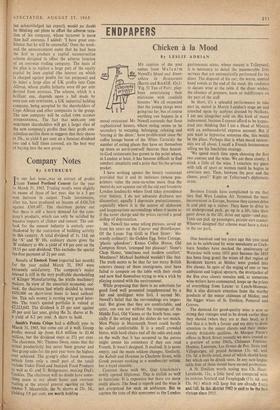Investment Notes
By CUSTOS
TDR announcement by ICI of a coming issue of £50 million 74 per cent unsecured loan stock at 984—the largest financing operation, it is said, ever undertaken by a British company— came at a time when the recent debenture issues were booming and a movement into the gilt-edged market had been set on foot. The result was a sharp drop in the debenture issues and a mark- ing-down of gilt-edged bonds. Some brokers are talking of a 'fundamental change' in market sentiment—that the cult of the equity is declining and that the future appreciation in redeemable gilt-edged stocks selling at a big discount will more than offset the decline in the value of money. Another run on sterling could, of course, put Bank rate up, but this is not considered likely, and the argument is now heard that the long-term rate of interest is at its peak and that as the Callaghan recession deepens it should fall. Cer- tainly this is the classic situation for a switch into the gilt-edged market from equities, which so far have suffered only a moderate fall. In a short time we may see the reverse yield gap (now 0.5 per cent) eliminated. -War Loan at 53166 yields 6.65 per cent.
Wool Shares
It is, of course, absurd to sell equity shares which have already suffered a substantial fall. Some trades have already had their recession and some companies are just emerging from a profit setbaek into a profit recovery. This is the case in the wool textile industry, which has seen a fall of 20-25 per cent in the price of the raw material between the first quarters of 1964 and 1965. As most wool companies' accounts end between December and March, some heavy stock losses had to be written off. At the same time, although the home market has been firm, woollen and worsted exports have fallen off. As yet there is little sign of an improvement in the export situation, but wool prices have firmed up and, in view of the severe drought in Australia, it is thought that at the coming wool auctions con- siderably higher prices will be seen. Here is an opportunity, then, for acquiring wool textile shares at prices which may be around the bottom of the market.
-Z z
• -• .c.)
E-a ,cu
›-t
J. Ambler 14/10+ 12/41- 20 1.0 8.0
*John Foster 15/6 12/9 20 1.5 7.5 *Illingworth Morris 'A' 7/104 5/6 124 1.1 8.7 *Parkland 'A' 15/9 13/74 174 1.9 6.2 Troydale Industries 7/6 6/6 274 2.0 8.1 *West Riding Worsted 66/3 54/- 18 1.7 6.5
Those marked with an asterisk are fully inte- grated groups in the woollen industry. JEREMIAD AMBLER is a high-quality worsted spinner, with synthetics accounting for 40 per cent of produc- tion. TROYDALE are worsted and woollen cloth manufacturers expanding into the higher-quality end of the trade. WEST RIDING is regarded as the blue chip of the industry and it is rare for it: shares to yield as much as 64 per cent.
Cope Allman In a note on COPE ALLMAN on July 23, I ven- tured to say that the chairman, Mr. I,. Machan (an acknowledged tax expert), would no doubt be thinking out plans to offset the adverse taxa- tion of his company, whose turnover is more than half overseas. I added: 'I have great con- fidence that he will be successful.' Over the week- end the announcement came that he had been the first to produce a capital reconstruction scheme designed to offset the adverse taxation of an overseas trading company. The basis of his plan is to replace a large part of the equity capital by loan capital (the interest on which is charged against profits for tax purposes) and to inject a large slice of UK profits into Cope Allman, whose profits hitherto were 60 per cent derived from overseas. The scheme, which is a brilliant one, depends upon a bid made by MIDLAND AND NORTHERN, a UK industrial holding company, being accepted by the shareholders of Cope Allman and other companies in the group. The new company will be called COPE ALLMAN INTERNATIONAL. The fact that MIDLAND AND NORTHERN shareholders will get a larger slice of the new company,s profits than their profit con- tribution entitles them to suggests that their shares at 10s., to yield 6 per cent on a forecast dividend two and a half times covered, are the best way of buying into the new group.































 Previous page
Previous page